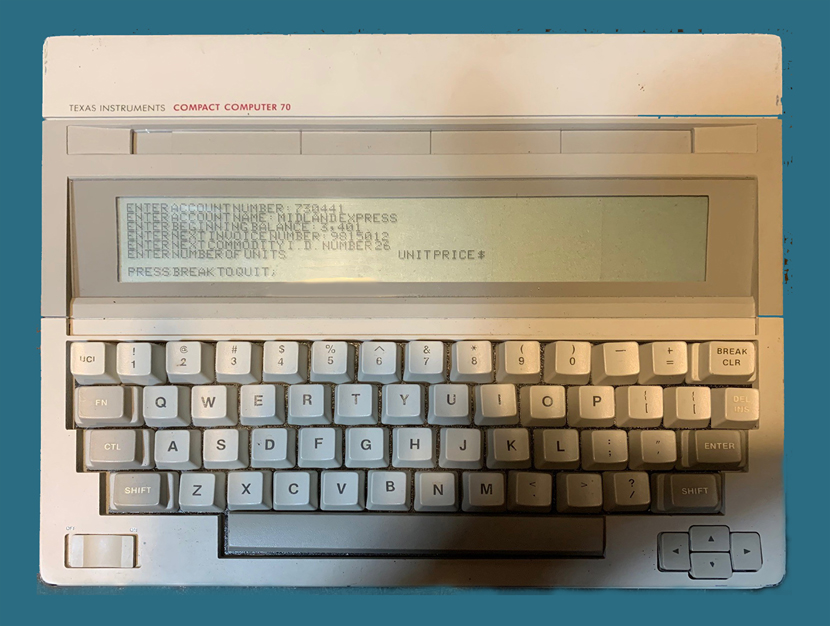
DATAMATH CALCULATOR MUSEUM
 |
DATAMATH CALCULATOR MUSEUM |
Texas Instruments Compact Computer 70 (Mockup)
| Date of introduction: | (never) | Display technology: | LCD dot matrix |
| New price: | SRP $550 SRP $650 w/ Option T |
Display size: | 8 * 80 characters) |
| Size: | |||
| Weight: | Serial No: | ||
| Batteries: | Date of manufacture: | ||
| AC-Adapter: | Origin of manufacture: | ||
| Precision: | Integrated circuits: | ||
| Memories: | |||
| Program steps: | Courtesy of: | Brian Green |

![]()
 Texas Instruments
started already in Summer 1977 the demanding "Project X"
leading not only to the TI Programmable 88
but this Compact Computer 70 Mockup, too. Three products were considered as
finalists in a Market Study dating July 1981:
Texas Instruments
started already in Summer 1977 the demanding "Project X"
leading not only to the TI Programmable 88
but this Compact Computer 70 Mockup, too. Three products were considered as
finalists in a Market Study dating July 1981:
|
• RM 1000: TI Programmable 88 • RM 2000: Compact Computer 40 • RM 3000: Compact Computer 70 |
The TI Programmable 88 or TI-88 was scrapped in September 1982, the Compact Computer 40 or CC-40 was introduced in January 6, 1983 and the Compact Computer 70 progressed obviously for different reasons not too far.
While the CC-40 was a pretty impressive device that can operate about 200 hours with its disposable alkaline batteries and keeps programs and user data even when powered off for several months, did it fail due to the lack of support for any archiving media. Texas Instruments consequently developed - after the epic failure of the HX-2000 Wafertape Digital Tape Drive - the Compact Computer 40 Plus with an integrated cassette port.
As of September 1982, Texas Instruments was finalizing plans for a family of Programmable Language Portable Computers based upon extensions of the ALC-A (Advanced Language Computer, Product A) and a library of application programs and language compilers to be used with this family. The planned product portfolio included three products with various options:
| • ALC-LC – SRP $119 (1k RAM, 18k ROM, BASIC) |
The ALC-LC was supposed to have a 16-character LCD display, reduced functionality BASIC language, no Plug-in modules but full ALC I/O bus (peripherals) compatibility.
The ALC-LC never materialized, its spiritual successor could be found with the TI-74 BASICALC introduced in 1986. Nevertheless were the TI-74 BASICALC and its sibling TI-95 PROCALC, a keystroke Programmable Calculator, based on the hardware and software of the Compact Computer 40 Plus.
|
• ALC-A2 – SRP $250 (2k RAM, 32k BASIC Plug-in ROM) SRP $270 (2k RAM, 64k Pascal Plug-in ROM) SRP $270 (2k RAM, 64k FORTRAN Plug-in ROM) |
Principally a multi-language version of the ALC-A with a ¼" thicker housing, the addition of a Plug-in (flat pack) programming language module, expansion of the language ROM space from 32k Bytes to 64k Bytes, and expansion of internal RAM capacity from 18k Bytes to 34k Bytes.
The ALC-A2 was realized with the Compact Computer 40, announced in January 1983 and available for the end user around June 1983 with multiple peripherals and application programs announced and/or made available.
| • ALC-C/T – SRP $550/$650 (8k RAM, 32k BASIC Plug-in ROM |
An expansion of the ALC-A2 to enhance the product for use in higher utility applications, specifically high level professional and managerial support. The ALC-C will be an ALC-A2 in a larger case with a 6-line by 40-character LCD display, full travel typewriter keyboard and built-in tape mass storage.
The ALC-T (Terminal) is a variation of the ALC-C and provides the added feature of a built-in 300 Baud modem and telecommunication software.
Texas Instruments was working on the Compact Computer 70 but as of today we have no evidence of a functional prototype of the device. Rumors are, that the first batch of Gate Arrays designed for the CC-70 were faulty.
 Dismantling
this unique CC-70 Mockup discovered in Summer 2020 by Brian Green in the Estate
of CB Wilson, VP Engineering with Texas Instruments in the 80s, reveals - just
an empty shell.
Dismantling
this unique CC-70 Mockup discovered in Summer 2020 by Brian Green in the Estate
of CB Wilson, VP Engineering with Texas Instruments in the 80s, reveals - just
an empty shell.
Looking back we are convinced that the Compact Computer 70 would
have been a very successful device, think about the Kyocera Kyotronic 85 introduced in
1983 and sold with some cosmetic changes as TRS-80 Model 100, Olivetti M-10, NEC
PC-8201, and PC-8300.
If you have additions to the above article please email: joerg@datamath.org.
© Joerg Woerner, December 23, 2020. No reprints without written permission.